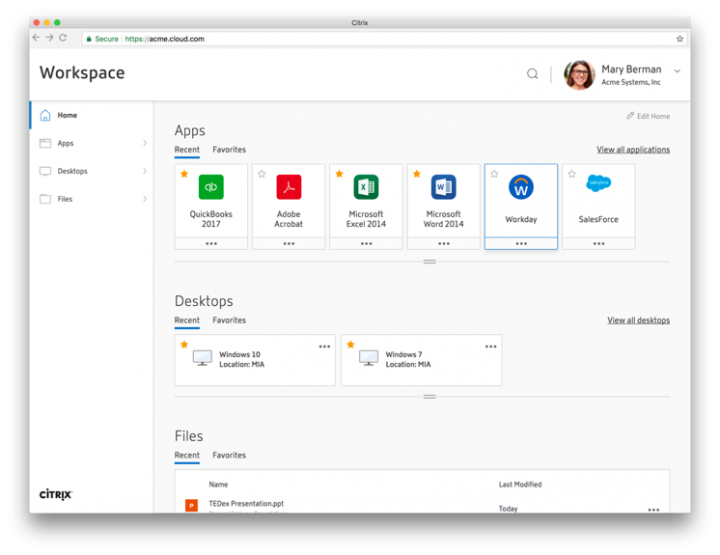Adam Lotz of Citrix Shares Expertise and Advice on Virtual Desktops, Security and Work From Home
WhatMatrix: The coronavirus pandemic has accelerated virtual desktop sales momentum. What are some of the big questions you are being asked to answer from companies shifting to work from home, and how are you answering those questions?

Adam Lotz, Principal Product Marketing Manager, Desktop & Applications Group
Adam Lotz: We’ve seen a tremendous surge in virtual app and desktop deployments, both from existing customers who are expanding their deployments, as well as new customers rolling out remote work initiatives for the first time.
For existing customers, or those familiar with VDI and app virtualization – the biggest questions we field are around scalability and resources needed to expand. How do they go from a 500-user deployment to a 2500 user deployment? Do they have enough compute, bandwidth, or storage – and if not, how do they get it? Do they have these skills in house or will they need to work with a partner or service provider? In most cases, these customers use Citrix Virtual Apps and Desktops service to deploy VDI in a hybrid-cloud model, leveraging their existing datacenter capacity where they can, and then adding new cloud regions to handle the unexpected excess, resulting in more predictable costs. Because we use the same set of administrative tools for workloads hosted on-prem or in the cloud, this is an easy transition to make. Citrix customers can choose any public cloud provider for hosting, and leverage our app and image management tools to deploy at scale across their organization.
Organizations that are new to app and desktop virtualization may have kicked the tires on VDI or DaaS use cases before, but often have a laundry list of questions and concerns. Cost, user experience, and manageability are big unknowns for these companies. Many don’t realize that desktop virtualization is an established industry with enterprise-class tools to simplify management, monitoring, and maintenance of their user images. Most are shocked to learn that a well-run VDI environment can show dramatic cost reductions compared to desktop management of similar devices. We’ve seen lots of success here with offerings like our Citrix Managed Desktops product, which is fully cloud-hosted and targeted at helping admins get up and running quickly.
WhatMatrix: Why do you think VDI has taken this long to really take off? Was the use case driven model too narrow? Was it technology holding it back?
Adam Lotz: Citrix has been an application virtualization pioneer for more than three decades, and while our technology has evolved dramatically over time, the business challenges we tackle have remained largely the same, including business continuity, remote work, and global expansion.
The biggest shift in our space over the last five years has been the rise of cloud computing, which brings new scalability and pay-as-you-go cost modeling to the VDI. The COVID-19 pandemic has accelerated the move to the cloud. This has enabled companies to expand beyond the reach of their on-premises datacenters, and grow their deployments as new users or scenarios come online. We’ve met this demand with our Virtual Apps and Desktops service offering, which gives administrators flexibility to run their workloads on-premises or in the cloud, while using our hosted services for management.
WhatMatrix: With more companies quickly implementing remote PC and work from home initiatives, what kind of security issues should they be aware of?
Adam Lotz: Unmanaged endpoints are one of the biggest risks of the sudden shift from employees out of the workplace and into their homes. We’ve heard countless stories of older devices being pulled out of basements, family computers suddenly enlisted as primary work machines, and employees powering up anything and everything to get connected to the office. While the global response to ensure business continuity has been nothing short of epic, these devices represent a huge threat to corporate data. Especially in cases where companies are allowing VPN connections or other “bridges” between home PCs and their internal networks, the risk of malicious attacks or malware spread goes up dramatically. Administrators need to be on guard for both malicious and inadvertent data loss in these scenarios, and of course we believe that securing that information in the datacenter is the best way to stay protected.
WhatMatrix: Now that companies have been “pushed” into the deep end of the pool of VDI/DaaS/Remote PC with forced work from home initiatives, do you think things will go back to normal or will they continue to allow some percentage of work from home?
Adam Lotz: The coronavirus pandemic has, in essence, created a forced experiment. Organizations that may have been reticent to consider remote work have come face-to-face with a situation that now requires it. And while perhaps not their choice, the vast majority of respondents to a survey of 10,000 workers in six countries that OnePoll did on our behalf believe it is the future of work. When asked if they believe working from home will be more common after the crisis, roughly two thirds of employees polled in all countries responded affirmatively.
And in a separate survey of 2,000 workers, 37 percent of employees polled said they think their organizations will be more relaxed about working from home and 32 percent indicated they plan to do so more often.
Employees won’t want to go back to how it was before, and there are a couple of reasons for this:
- Returning to the office will not mean returning to normal. It’s going to be a rough environment until there is a vaccine. 46 percent of the employees OnePoll surveyed said they won’t feel comfortable returning to the office until there is one available to the masses and that is likely a year or two away.
- Going to the office used to be fun – you could see your colleagues and have those watercooler conversations. Now you’re going to have to wear PPE and maintain social distancing with no access to gyms and cafeterias. And a lot of people just don’t want to deal with that.
- Research says the average person is productive for about two and a half hours a day in the traditional workplace because of distraction. 70 percent plus of the people we surveyed believe they are more productive working remote.
So, I think you’re going to see a hybrid model where people go to a physical location if they have to, but they’ll spend the rest of their time working remotely and be just as productive. And many of the organizations we talk to are confirming this. While they are still defining what “normal” may look like for 2020, 2021, and beyond, some of these companies are planning a staged return to offices, with A/B teams, time-shifting of work. A surprisingly large number have said they have no immediate plans to resume typical office behavior, and a few have even said that based on continued employee productivity, they see no particular need to return to the office at all.
WhatMatrix: Can you explain what your solution or offering does specifically to help with work from home strategies?

Adam Lotz: Citrix Virtual Apps and Desktops lets companies meet their employees where they are and give them the tools they need and prefer to use to do their best work – whether they are at home, in the office or on the road. The solution offers administrators a number of options for enabling secure, remote access to corporate data from any device, on any network. With our Virtual Apps and Desktops product line, IT can host their Windows or Linux apps or desktops in the datacenter or cloud, providing virtualized access via our Workspace App client. Available on any platform and even in an HTML5 version, Workspace App allows end users to interact with their remote applications as if they are running locally, even on low bandwidth connections or outdated devices. Through policy controls, admins can restrict capabilities like drive mapping, clipboard access, or printing, adding additional layers of protection for corporate data. Unlike VPN solutions which can dangerously bridge the end user’s device with your internal network, the virtual session runs strictly on your corporate network, providing a layer of isolation while still giving end users high performance access to internal resources and data.
WhatMatrix: Why should a company choose your solution? What are your differentiators?
Adam Lotz: Citrix is a leader in the application virtualization space and has more than 30 years of experience in providing remote work solutions to organizations of all sizes. With Citrix, companies can provide a consistent work experience that allows employees to perform at their best – wherever they happen to be. For administrators, we have flexible offerings that can be deployed fully on-premises, in public clouds, or in a hybrid mixture of both. Advanced tools for image and application management minimize downtime for updates, and dedicated helpdesk tools allow for easy day to day maintenance. Desktops can be hosted in both single- and multi-user deployments, letting admins choose between maximum flexibility or density.
End users love our high-definition HDX protocol which ensures the best user experience for accessing content, regardless of connection. Innovations here enable rich multimedia support, interactive communications such as VOIP solutions, and even specific optimizations for Teams, Skype, and Zoom.
WhatMatrix: Is your company doing anything specific, outside of selling your solution, to help work from home or the community in general?
Adam Lotz: We stared out anticipating in January that companies would need to prepare for and deliver remote work on a wide scale and we put a lot of different offers in place to provide very low-cost burst capacity licensing for both new and existing customers to help them scale up and drive business continuity across everything they are doing.
Our teams worked around the clock to help our customers trouble shoot, debog and really get their employees to a place where they can be safe, secure and productive. Many are now building out their infrastructure to support remote work on a wide scale and deliver a superior experience for their employees whether they are working from home of in the office using Citrix as the foundation.
We also launched a Remote Works Resource Center where companies can access insights and best practices and technology demonstrations they can use to build and manage a remote work culture.
WhatMatrix: How does your solution address user concerns around data privacy and control over personal data? Can you describe your view on these challenges?
Adam Lotz: With the sudden shift to work from home, a plethora of new and old personal devices have come online to access work content. We have seen some customers expand their remote work footprint from hundreds of users connecting a day to thousands, and certainly IT wasn’t prepared to deliver secure devices to end users at that kind of scale. Our model is simple – the Citrix Workspace App is a small footprint native or HTML5 based client that provides all the access the user needs. Data on the device remains on the device, and data inside the session – your corporate apps, desktops, and data – remains protected back in the datacenter or cloud. Users don’t have to worry about invasive IT policies or accidental overreach, because their devices are simply being used as interaction points for the desktop itself. IT, similarly, can be confident in the security of their data – customers in finance, healthcare, and legal industries trust the Citrix solution to prevent accidental data leakage. With our App Protection technology enabled, we can even block malicious attempts at keylogging and screen scraping malware that could be running on the user’s device. We find application virtualization to be easier for end users and more secure for IT, all while reducing the management burden of desktop deployments.
WhatMatrix: Finally, do you have any advice to a company currently planning or in the process of implementing a VDI or DaaS solution?
Adam Lotz: The sudden shift to work-from-home has created an immediate need for remote access technologies. Organizations that had already invested in VDI, Application Virtualization, or DaaS technologies found themselves well equipped to ramp up those deployments and enable business continuity. Looking forward, we see 2020 redefining our ideas on what it means to “go to work” and technology must evolve with it. Work with vendors to understand how they can solve your immediate challenges, while providing a clear path forward for resiliency and grow
WhatMatrix : Thanks Adam some great insights there. For anyone wanting more infomation on Citrix solutions head over to our comprehesive WhatMatrix evaluations on : Desktop as a Service, App Layering and Application Virtualization


Latest posts by Community Author (see all)
- WhatMatrix Q&A with Citrix– Virtual Desktop, DaaS, VDI and WVD - July 5, 2020
- We hope you are well – help for vendors – free lead generation - March 27, 2020
- Landscape Report Guidance: Cloud Management Platforms - February 5, 2020





